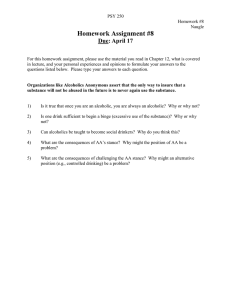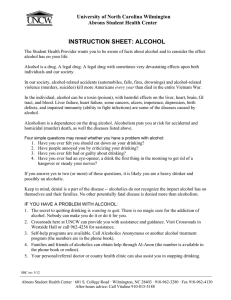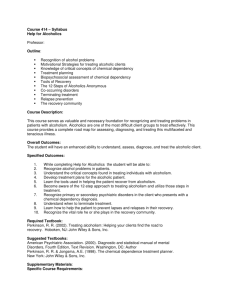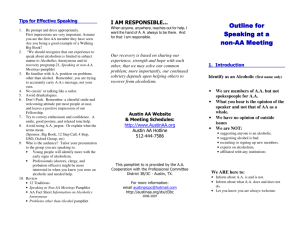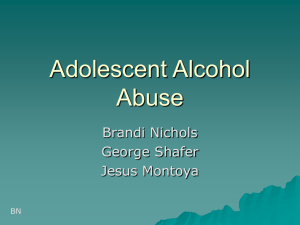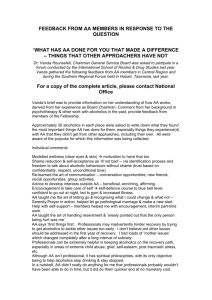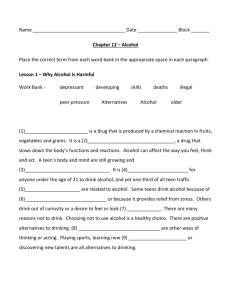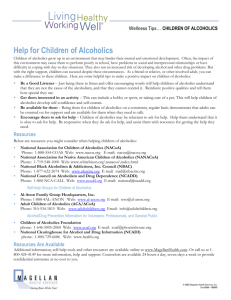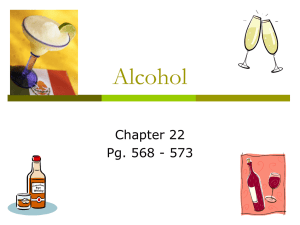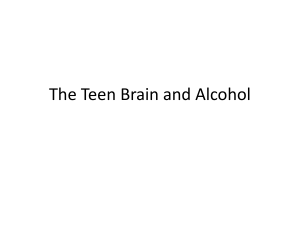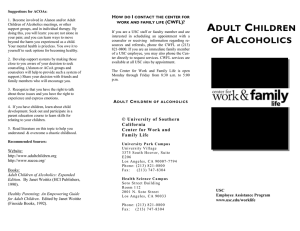Alcohol: Effects, Risks, and Recovery Presentation
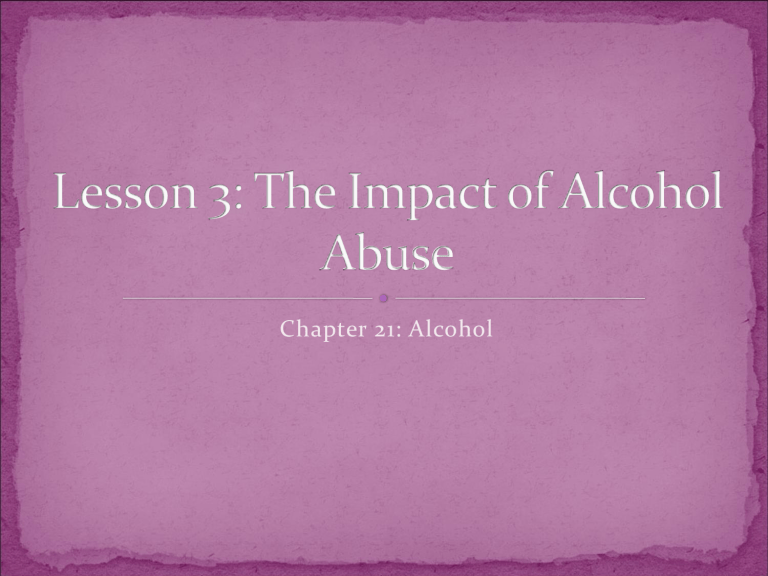
Chapter 21: Alcohol
One-fifth of all teen drivers involved in fatal car accidents have a blood alcohol concentration of 0.01 percent.
If you under the age of 21, it is against a law to drive with a 0.02 or greater.
A persons blood alcohol concentration (BAC) is the amount of alcohol in a persons blood, expressed as a percentage.
BAC depends on the quantity and type of alcohol that was consumed, the rate of consumption, and body size and gender.
Any amount of alcohol in the blood can cause the following:
Slow reflexes
Reduced ability to judge distance and speeds
Increase in risk-taking behaviors
Reduced concentration and increased forgetfulness
Drink
Beer
(12 oz.)
Wine
(5 oz.)
Vodka or Whiskey
(1.25 oz.)
Alcohol by Volume
4%
10%
40%
Alcohol Content
0.5 oz.
0.5 oz.
0.5 oz.
Driving while intoxicated (DWI), or driving under the influence (DUI), is illegal.
Adult drivers who have a BAC of 0.08 percent can be charged with drunk driving.
For those under 21, there is no acceptable BAC, since it’s illegal to use alcohol.
The consequences for a DWI or DUI include
Injuries to or death of the driver and others.
Arrest, jail time, court appearance and fine or bail, a police record, and possibly lawsuit.
Severely restricted driving privileges and/or immediate confiscation of driver’s license.
Higher auto insurance rates or a canceled insurance policy.
When a pregnant female drinks, alcohol passes directly from her body into the bloodstream of the fetus.
Fetal alcohol syndrome
(FAS)- is a group of alcohol-related birth defects that include physical and mental problems.
The effects of FAS:
Small head and deformities of face, hands, or feet.
Heart, liver, and kidney defects.
Difficulties learning and short attention span.
Hyperactivity, anxiety, and social withdrawal.
FAS is one of the leading preventable causes of mental retardation.
Symptoms include:
Craving- feeling a strong need for alcohol to manage tension or stress, and a preoccupation with alcohol.
Loss of control- inability to limit alcohol consumption.
Physical dependence- withdrawal symptoms, such as nausea, sweating, shakiness, and anxiety.
Tolerance- a need to drink increasingly more alcohol ion order to feel the effects.
An alcoholic is an addict who is dependent on alcohol.
The behavior of alcoholics varies-some are aggressive and violent, while others may become withdrawn.
Alcoholism is not limited to any age, race, ethnic or socioeconomic group.
Growing scientific evidence suggests that alcoholism is partially due to genetics.
Studies have shown that children of alcoholics are four times more likely to become alcoholics.
Teens who start drinking are at a higher risk of becoming alcoholics during their lifetime than people who begin drinking as adults.
Stage 1-Abuse.
Alcoholism may begin with social drinking. The person may experience memory loss and blackouts, and may begin to lie or make excuses to justify his or her drinking.
Stage 2-Dependence. The person cannot stop drinking and is physically dependent on the alcohol.
Stage 3-Addiction. In the final stage of alcoholism, the person is addicted. At this stage, the liver may be already damaged, so less alcohol may be required to cause drunkenness.
The United States is home to an estimated 15 million alcoholics and problem drinkers.
Alcohol abuse affects more than just the drinker.
It is a major factor in the four leading causes of accidental death: car accidents, falls, drowning, and house fires.
About 40 percent of violent crimes are alcohol related.
Often, people close to alcoholics develop mentally unhealthy behaviors, such as codependency.
Codependents ignore their own emotional and physical needs and instead focus their energy and emotions on the needs of the alcoholic.
Recovery is the process of learning to live an alcohol-free life.
Recovering alcoholics must make a lifelong commitment to sobriety-living without alcohol.
Here are a few resources and programs:
Al-Anon/Alateen-helps families and friends learn to deal with the effects of living with an alcoholic.
Alcoholics Anonymous
MADD
National Association for Children of Alcoholics
SADD
SAMSHA’s National Clearinghouse for Alcohol and Drug
Information
